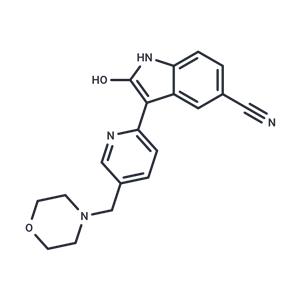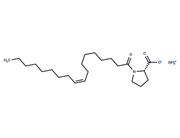| Name | AZD1080 |
| Description | AZD1080 is a selective, orally active, brain permeable GSK3 inhibitor. |
| Cell Research | 3T3 fibroblasts are engineered to stably express four-repeat tau protein. These cells have high endogenous levels of GSK3 that is able to phosphorylate tau protein constitutively. This phosphorylation is inhibited by LiCl. After treatment with different compounds, cultures are washed twice with 5 mM MgCl2-PBS. Extracts for Western blot analysis are prepared by homogenizing cells in ice-cold extraction buffer consisting of 20 mM HEPES, pH 7.4, 100 mM NaCl, 10 mM NaF, 1% Triton X-100, 1 mM sodium orthovanadate, 10 mM EDTA, and protease inhibitors (2 mM phenylmethylsulfonyl fluoride, 10 μg/ml aprotinin, 10 μg/ml leupeptin, and 10 μg/ml pepstatin). The samples are homogenized at 4 °C, and protein content is determined by Bradford method. Total protein (25 μg) is electrophoresed on 10% SDS-PAGE gel and transferred to a nitrocellulose membrane. The experiments are performed using the following primary antibodies: tau Ser(P)-396, 1:1000; Tau5, 1:1000; and anti-GSK3β, 1:1000. The filters are incubated with the antibody at 4 °C overnight in 5% nonfat dried milk. A secondary antibody (1:5000), followed by ECL detection reagents are used for immunodetection. Quantitation of immunoreactivity is performed by densitometric scanning.(Only for Reference) |
| Kinase Assay | Kinase Assay: GSK3 scintillation proximity assay is done. The competition experiments are carried out in duplicate with 10 concentrations of the inhibitor in clear-bottomed microtiter plates. The biotinylated peptide substrate biotin-AAEELDSRAGS(PO3H2)PQL, is added at a final concentration of 2 μM in an assay buffer containing 6 milliunits of recombinant human GSK3 (equal mix of both α and β), 12 mM MOPS, pH 7.0, 0.3 mM EDTA, 0.01% β-mercaptoethanol, 0.004% Brij 35, 0.5% glycerol, and 0.5 μg of bovine serum albumin/25 μl and preincubated for 10–15 min. The reaction is initiated by the addition of 0.04 μCi of [γ-33P]ATP and unlabeled ATP in 50 mM Mg(Ac)2 to a final concentration of 1 μM ATP and assay volume of 25 μl. Blank controls without peptide substrate are used. After incubation for 20 min at room temperature, each reaction is terminated by the addition of 25 μl of stop solution containing 5 mM EDTA, 50 μM ATP, 0.1% Triton X-100, and 0.25 mg of streptavidin-coated SPA beads corresponding to 35 pmol of binding capacity. After 6 h the radioactivity is determined in a liquid scintillation counter. |
| In vitro | AZD1080 reverses cognitive deficits in mice and rescues their dysfunctional synapses. Oral administration of AZD1080 inhibits tau protein phosphorylation in the rat brain, with a peak brain/plasma exposure ratio of 0.5-0.8. Acute oral intake of AZD1080 suppresses peripheral GSK3 activity in a dose-dependent manner, reducing the phosphorylation ratio of glycogen synthase to total glycogen synthase, achieving an average maximum inhibition of 49% at the highest dose of 10mol/kg. |
| In vivo | AZD1080 inhibits tau phosphorylation in cells expressing human tau with an IC50 of 324 nM. It also inhibits human GSK3α and GSK3β with Ki values of 6.9 nM and 31 nM, respectively, demonstrating over 14-fold selectivity against cdk2, cdk5, cdk1, and Erk2. |
| Storage | Powder: -20°C for 3 years | In solvent: -80°C for 1 year | Shipping with blue ice. |
| Solubility Information | Ethanol : < 1 mg/mL (insoluble or slightly soluble)
DMSO : 40 mg/mL (119.63 mM), Sonication is recommended.
|
| Keywords | AZD-1080 | Glycogen synthase kinase-3 | AZD1080 | Glycogen synthase kinase 3 | Inhibitor | GSK-3 | AZD 1080 | inhibit |
| Inhibitors Related | PHA-767491 | Cromolyn sodium | GSK 3 Inhibitor IX | CHIR-99021 | AT7519 | 5-Bromoindole | 4-Chloro-2'-bromoacetophenone | SNS-032 | CHIR-99021 HCl | GSK-3 Inhibitor 5 | MeBIO | 1-Azakenpaullone |
| Related Compound Libraries | Anti-Neurodegenerative Disease Compound Library | Bioactive Compound Library | Kinase Inhibitor Library | Anti-Cancer Clinical Compound Library | Drug Repurposing Compound Library | Neuroprotective Compound Library | Inhibitor Library | Anti-Aging Compound Library | Bioactive Compounds Library Max | Anti-Cancer Drug Library |

 United States
United States



